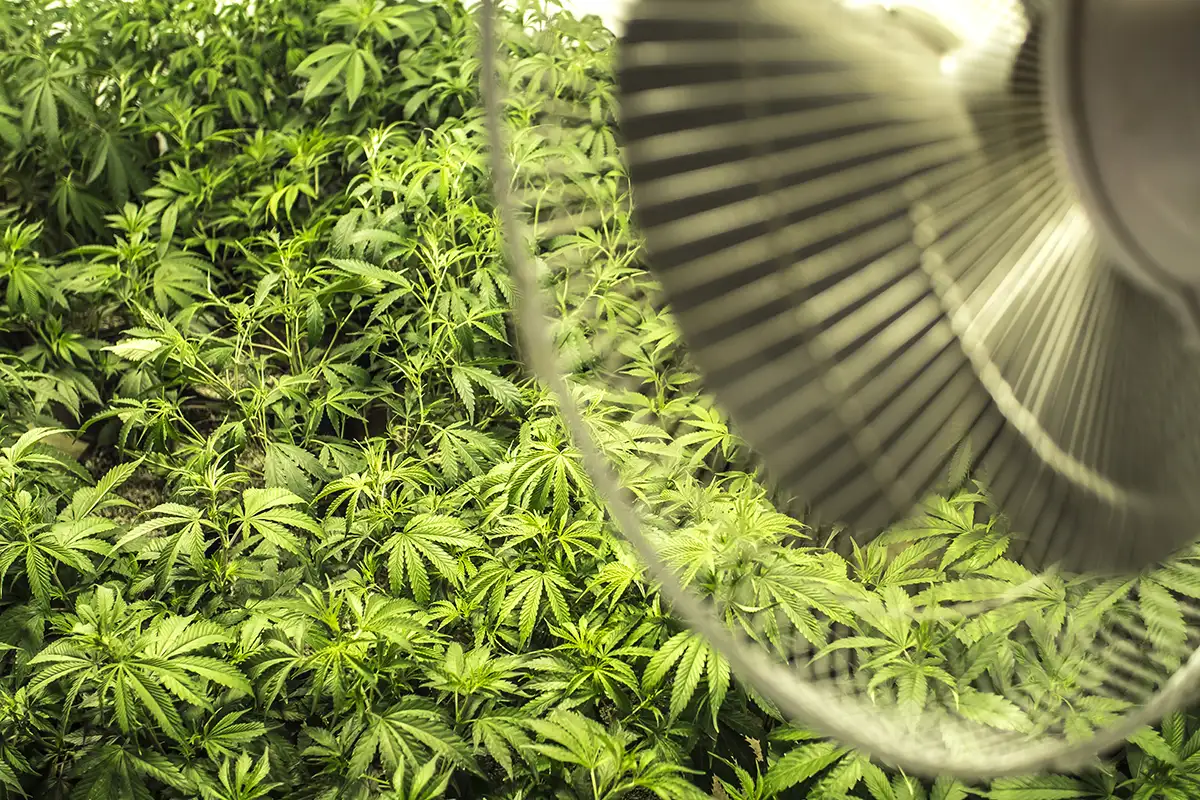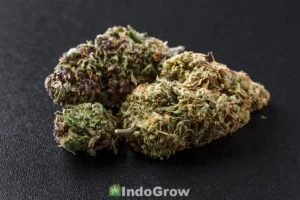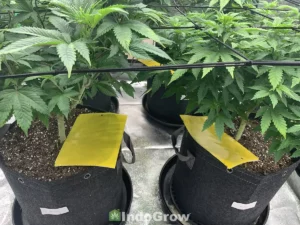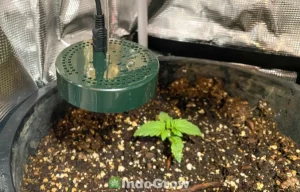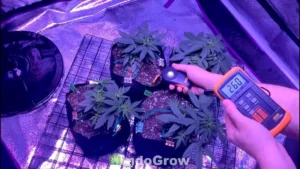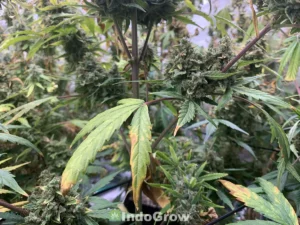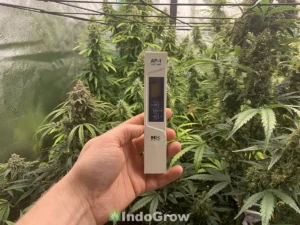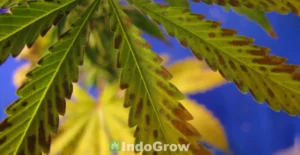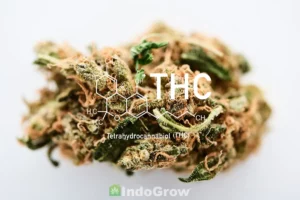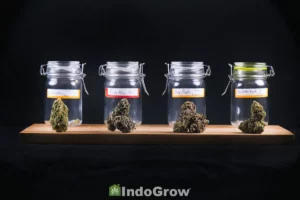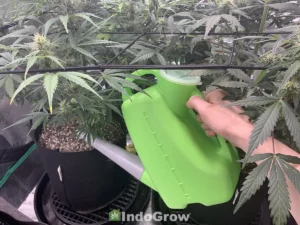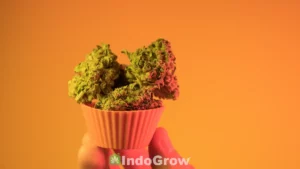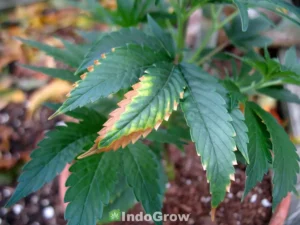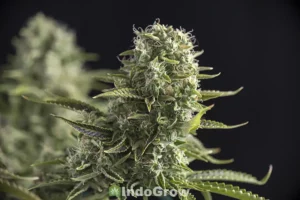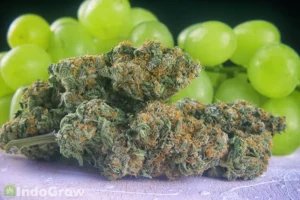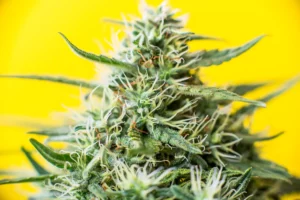Cannabis heat stress occurs when temperatures in the grow room become too high for the plant to cool itself down naturally. While heat stress can cause worrying symptoms in the leaves and flowers, this condition is easily resolved by lowering temperatures and increasing airflow. This article will discuss the common symptoms of marijuana heat stress, and suggest a wide variety of solutions and preventative measures to bring your crop back to full health.
Table of Contents
- Symptoms of Heat Stress in Cannabis
- How to Fix Heat Stress in Cannabis Plants
- Add a portable Air Conditioning Unit or Swamp Cooler to the grow room.
- Dim and/or Raise Your Grow Lights
- Run Your Grow Lights at Night Instead of During the Day
- Increase Exhaust Fan Speed to Remove More Hot Air
- Increase Oscillating Fan Speed to Increase Air Flow
- Add CO2 to Your Grow Room
- Use Nutrient Supplements to Help with Increase Heat Resistance
- Conclusion
Symptoms of Heat Stress in Cannabis
Some common symptoms of cannabis heat stress include yellowing or browning of the leaves, cupping on the leaf tips, and slowed growth. When temperatures get too high, cannabis plants can no longer cool themselves down through the release of water vapor from their leaves, and their cells begin to take damage. Cannabis plants often present different symptoms in the vegetative and flowering stages, which will be discussed in greater detail below.
Symptoms of Heat Stress in the Vegetative Stage
In the vegetative stage, heat stress will cause symptoms on the leaves such as cupping upwards, dry yellow or brown spots, and curled, burnt tips. Browning usually appears at the top of the plant first, and progresses down towards the base if the temperature does not drop.
Besides damage to the leaves, heat stress will cause stunted growth. Excessive heat near the base of the plant can also cause harmful bacteria to proliferate and cause root rot, especially in hydroponic plants.
Heat stress can also affect seedlings, which will display pale, stunted new growth in excessive heat. Seedlings are not as resilient to heat stress as older plants, and extreme heat may kill them in as little as a single day if they are not cooled down.
Symptoms of Heat Stress in the Flowering Stage
Symptoms of marijuana heat stress in flowering plants include bleaching on the upper leaves and flowers, spindly “foxtail” buds, and excessive white hairs/ pistils on buds. Although heat stress may appear to accelerate bud production at first, new buds will be wispy and insubstantial with poor flavor and potency.
Flowering plants can also experience leaf symptoms such as cupping, burnt leaf tips, and brown or yellow spots. This can be particularly problematic for later stage flowering plants who can no longer produce new fan leaves to replace those damaged by cannabis heat stress.
How to Fix Heat Stress in Cannabis Plants
Cannabis heat stress can be solved by lowering the temperature and increasing the airflow in your grow area. Lowering the temperature as quickly as possible is essential to prevent long term damage to your plants.
Specific strategies to combat heat stress include adding an AC unit or swamp cooler, dimming or raising your grow lights, adjusting your lighting schedule, increasing exhaust and oscillating fan speed, adding CO2, or adding specific nutritional supplements. Read on for a detailed description of each of these possible interventions.
Add a portable Air Conditioning Unit or Swamp Cooler to the grow room.
Adding an AC unit or Swamp cooler is a surefire way to lower temperatures quickly and permanently. Although these appliances will increase your electricity use, they are one of the most reliable ways to keep your plants cool in hot climates.
An AC unit can be used to pump cool air directly into your grow tent. Because they tend to be large and unwieldy, AC units are usually placed in the room outside of the tent. Ducting can then be used to direct the cool air into the growing area.
Swamp coolers, or evaporative coolers, function by passing air over water saturated sponges. The water then evaporates into water vapor, cooling the area and raising the humidity. Swamp coolers use much less electricity than conventional air conditioners, and have the added benefit of adding humidity to the air. Similar to AC units, the swamp cooler is typically placed in the room just outside the grow tent to save space.
While swamp coolers can be extremely effective at cooling hot, dry air, they will not function properly in spaces with high humidity. If your tent is both hot and humid, a conventional AC unit will be far more effective at lowering temperatures than a swamp cooler.
Dim and/or Raise Your Grow Lights
Lights that are too bright or too close to the top of your plants can cause both heat stress and light burns. In addition to the classic symptoms of heat stress, excessive lighting can cause bleaching of the leaves and buds at the top of the plant. Bleached buds have significantly lowered potency and worse flavor compared to healthy buds, so addressing lighting concerns as soon as you spot them is essential.
Although grow lights can use a variety of metrics to describe their light output, PPFD is the most relevant to growing cannabis. PPFD, or Photosynthetic Photon Flux Density, is a measure of how much light in the photosynthetically active spectrum is reaching the canopy of a plant.
PPFD can be measured using a PAR (Photosynthetically active radiation) meter. Ideal PPFD for cannabis without C02 supplementation is between 600-900. While bright light can help plant photosynthesize more effectively, lighting producing 1300-1500 PPFD or more is likely to be harmful to your plants.
If you suspect your lighting is producing too much heat or lighting intensity, consider dimming or raising the lights. After your adjustments, PPFD should be below 1000 and temperatures should be below 85 for vegetative plants or below 80 for flowering plants.
Run Your Grow Lights at Night Instead of During the Day
If you live in a hot climate, flipping the day night cycle of your plants may help you combat weed heat stress. Since late morning to early evening tends to be the hottest time of day, turning off your grow lights during this time will allow you to keep the temperatures in your grow tent more consistent. The heat produced by grow lights will be less detrimental at night when outdoor temperatures naturally decrease.
In order for this strategy to work, you must make your tent completely lightproof during the day through the use of blackout curtains or other light proofing methods. If sunlight reaches your tent during the day, it can both confuse your plants’ day/night schedule and increase temperatures inside the tent.
Increase Exhaust Fan Speed to Remove More Hot Air
Another strategy to cool your grow room is increasing the speed of your exhaust fan. The amount of air your exhaust fan can move is measured in CFM, or cubic feet per minute. In general, your exhaust fan should be fully replacing the air in your grow tent at least once per minute. This means that for a 4x4x6 grow tent, you will need an exhaust fan with a minimum CFM of 96 CFM.
If your tent is still too hot, you may want to increase the CFM of your exhaust fan so that the air is being replaced 2-3 times per minute. For the same 4x4x6 tent, this would be 192 to 288 CFM.
Another factor to consider with exhaust fans is your grow room’s VPD, or vapor pressure deficit. Cannabis plants lose 95-98% of the water they take in through a process called transpiration, where the plants release water vapor in order to cool down and access C02 in the air. Excessive heat to humidity ratios can cause the VPD to fall into an unhealthy range and upset your cannabis plant’s metabolism. Fortunately, a strong exhaust fan can help you control the heat and humidity of your grow room and prevent the air from becoming excessively hot or humid.
Increase Oscillating Fan Speed to Increase Air Flow
While exhaust fans can help replace air in the grow room, oscillating fans circulate the air around the tent and keep pockets of hot, stale air from forming. You will need at least two oscillating fans in your tent, one pointed at the canopy and another pointed at the top of the soil. If you notice any areas of the tent have no breeze, you may need to move your fans or add additional fans.
Oscillating fans are a better choice than stationary fans for growing cannabis, as they allow for a greater range of air movement and decrease the risk of pockets of hot, humid air forming. If even small areas of the tent do not receive proper airflow, plants in these pockets of still air can experience heat stress even if plants elsewhere in the tent appear healthy.
Add CO2 to Your Grow Room
Adding CO2 to your grow room/tent can allow your plants to survive at much higher heat and light levels than normal. Additional CO2 in the air allows plants to photosynthesize more effectively, and their heightened metabolisms need higher heat and light levels to perform optimally.
With CO2 concentrations of at least 1200 ppm, cannabis plants can survive at temperatures up to 95 degrees F, with a preferred temperature of about 85 degrees. Additionally, the plants can be grown under lighting with up to 1500 PPFD without risk of light burn.
CO2 supplementation only works in grow rooms or tents that are completely sealed to the outside, as the CO2 gas would otherwise escape. You will need to add an active intake fan to replace passive intake vents, and tightly seal any cracks, windows, doorways, or other areas where gas exchange with the outside could occur. Once this is complete, you can begin adding a CO2 supplement.
Supplementation should begin within the first 2-5 weeks of life, so that the cannabis plants can become acclimated to the increased CO2 levels. Increased CO2 levels should be maintained throughout the vegetative and flowering phases for best results. Cannabis grown in a CO2 rich environment under sufficiently intense lighting should show a 20-25% percent increase in yield over plants grown without supplementation.
One of the most popular methods for home growers to increase CO2 levels is by using Exhale bags. These bags are filled with a non fruiting mycelium culture that produces enough CO2 to increase concentrations in most home grow tents to 1200-1500 ppm for up to 6 months. A standard sized bag can produce enough CO2 to enrich 3-6 plants, while an XL bag can provide CO2 to as many as 12 plants.
Use Nutrient Supplements to Help with Increase Heat Resistance
Some nutritional supplements such as Seaweed kelp extract, humic acid, and silica can help prevent marijuana heat stress by increasing the plants’ natural heat resistance. These supplements should be added to regular feedings at the first signs of heat stress or increased temperatures for best results.
Seaweed Kelp Extract
Seaweed kelp extract contains a wide variety of micronutrients that can reduce symptoms of weed heat stress and increase yields. This natural product is usually sold as a premixed liquid supplement, but can also be found in powdered form.
Humic Acid
Humic acid is a naturally occuring substance in soil that can offer cannabis plants some protection against heat stress and drought. Some studies suggest that combining humic acid and kelp extract provides greater benefits than using either product individually. Humic acid is commercially available as a water soluble powder or liquid solution derived from naturally occurring leonardite.
Silica
Silica is a nutritional supplement that encourages plants to build more robust cell walls. This offers some protection from heat and drought, and also makes the plant less likely to bend or break under the weight of its own buds. Silica is available as a liquid supplement from a variety of common fertilizer brands.
Conclusion
Cannabis heat stress can cause worrying symptoms in your plants including curled leaves, brown or yellow spotting on the leaves, burnt leaf tips, wispy buds, and more. Fortunately, once you take steps to lower the temperature and increase airflow, your plants should recover within a couple weeks. Paying close attention to temperature and humidity parameters, and adding protective supplements such as kelp extract and humic acid can help you avoid marijuana heat stress in the future.

Rocky Horton
Author
Rocky Horton is an experienced cannabis grower and the founder of IndoGrow. The IndoGrow editorial team has over four decades of combined growing experience. Learn more.

